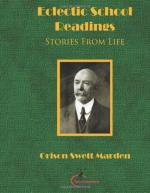Such, according to some biographers, was the turning point in the career of Antonio Canova, who, from a peasant lad, born in the little Venetian village of Possagno, rose to be the most illustrious sculptor of his age.
Whether or not the story be true, it is certain that when the boy was in his thirteenth year, Signer Falieri placed him in the studio of Toretto, a Venetian sculptor, then living near Asola. But it is equally certain that the fame which crowned Canova’s manhood, the title of Marquis of Ischia, the decorations and honors so liberally bestowed upon him by the ruler of the Vatican, kings, princes, and emperors, were all the fruits of his ceaseless industry, high ideals, and unfailing enthusiasm.
The little Antonio began to draw almost as soon as he could hold a pencil, and the gown of the dear old grandmother who so tenderly loved him, and was so tenderly loved in return, often bore the marks of baby fingers fresh from modeling in clay.
Antonio’s father having died when the child was but three years old, his grandfather, Pisano, hoped that he would succeed him as village stonecutter and sculptor. Delicate though the little fellow had been from birth, at nine years of age he was laboring, as far as his strength would permit, in Pisano’s workshop. But in the evening, after the work of the day was done, with pencil or clay he tried to give expression to the poetic fancies he had imbibed from the ballads and legends of his native hills, crooned to him in infancy by his grandmother.
Under Toretto his genius developed so rapidly that the sculptor spoke of one of his creations as “a truly marvelous production.” He was then only thirteen. Later we find him in Venice, studying and working with ever increasing zeal. Though Signor Falieri would have been only too glad to supply the youth’s needs, he was too proud to be dependent on others. Speaking of this time, he says: “I labored for a mere pittance, but it was sufficient. It was the fruit of my own resolution, and, as I then flattered myself, the foretaste of more honorable rewards, for I never thought of wealth.”
Too poor to hire a workshop or studio, through the kindness of the monks of St. Stefano, he was given a cell in a vacant monastery, and here, at the age of sixteen, he started business as a sculptor on his own account.
Before he was twenty, the youth had become a master of anatomy, which he declared was “the secret of the art,” was thoroughly versed in literature, languages, history, poetry, mythology,— everything that could help to make him the greatest sculptor of his age,—and had, even then, produced works of surpassing merit.
Effort to do better was the motto of his life, and he never permitted a day to pass without making some advance in his profession. Though often too poor to buy the marble in which to embody his conceptions, he for many years lived up to a resolution made about this time, never to close his eyes at night without having produced some design.




